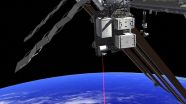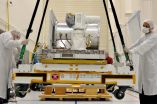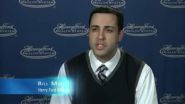HOUSTON, TX, March 11, 2014 (Press-News.org) What's more interesting than videos of cats chasing laser beams over the kitchen floor? How about videos sent OVER laser beams from NASA's International Space Station back to Earth?
A team of about 20 working at NASA's Jet Propulsion Lab in Pasadena, Calif., through the lab's Phaeton early-career-hire program, led the development of the Optical Payload for Lasercomm Science (OPALS) investigation, which is preparing for a March 16 launch to the International Space Station aboard the SpaceX-3 mission. The goal? NASA's first optical communication experiment on the orbital laboratory.
Scientific instruments used in space missions increasingly require higher communication rates to transmit gathered data back to Earth or to support high-data-rate applications, like high-definition video streams. Optical communications--also referred to as "lasercom"--is an emerging technology where data is sent via laser beams. This offers the promise of much higher data rates than what is achievable with current radio frequency (RF) transmissions and has the advantage that it operates in a frequency band that is currently unregulated by the Federal Communications Commission.
"Optical communications has the potential to be a game-changer," said mission manager Matt Abrahamson. "Right now, many of our deep space missions communicate at 200 to 400 kilobits per second." OPALS will demonstrate up to 50 megabits per second and future deep space optical communication systems will provide over one gigabits per second from Mars.
"It's like upgrading from dial-up to DSL," added project systems engineer Bogdan Oaida. "Our ability to generate data has greatly outpaced our ability to downlink it. Imagine trying to download a movie at home over dial-up. It's essentially the same problem in space, whether we're talking about low-Earth orbit or deep space."
OPALS is scheduled to launch aboard a SpaceX Falcon 9 rocket, part of a cargo resupply mission to the space station. The payload will be inside the Dragon cargo spacecraft. Once deployed, OPALS will be conducting transmission tests for a period of nearly three months, with the possibility of a longer mission. After the Dragon capsule docks with the station, OPALS will be robotically extracted from the trunk of the Dragon, and then manipulated by a robotic arm for positioning on the station's exterior. It is the first investigation developed at JPL to launch on SpaceX's Falcon rocket.
The technology demo was conceived, developed, built and tested at JPL by engineers in the early stage of their careers in order to gain experience building space hardware and developing an end-to-end communication system. The system uses primarily commercial off-the-shelf hardware and encloses electronics in a pressurized container. "We were not as constrained by mass, volume or power on this mission as we were by cost," said Abrahamson, and this approach allowed a lower cost development on an efficient schedule.
As the space station orbits Earth, a ground telescope tracks it and transmits a laser beacon to the OPALS. While maintaining lock on the uplink beacon, the orbiting instrument's flight system will downlink a modulated laser beam with a formatted video. Each demonstration, or test, will last approximately 100 seconds as the station instrument and ground telescope maintain line of sight. It will be used to study pointing, acquisition and tracking of the very tightly focused laser beams, taking into account the movement of the space station, and to study the characteristics of optical links through Earth's atmosphere. NASA will also use OPALS to educate and train personnel in the operation of optical communication systems.
The success of OPALS will provide increased impetus for operational optical communications in NASA missions. The space station is a prime target for multi-gigabit per second optical links. Fast laser communications between Earth and spacecraft like the station or the Mars Curiosity rover would enhance their connection to engineers and scientists on the ground as well as to the public.
OPALS is a partnership between NASA's Jet Propulsion Laboratory in Pasadena, Calif.; the International Space Station Program based at Johnson Space Center in Houston; Kennedy Space Center in Florida; Marshall Space Flight Center in Huntsville, Ala., and the Advanced Exploration Systems Division at NASA Headquarters in Washington.
David Israel & Mark Whalen
NASA's Jet Propulsion Laboratory
International Space Station to Beam Video via Laser Back to Earth
A team at NASA's Jet Propulsion Lab in Pasadena, Calif. led the development of the Optical Payload for Lasercomm Science investigation, NASA's first optical communication experiment from the space station, which launches March 16 aboard SpaceX-3.
2014-03-11
ELSE PRESS RELEASES FROM THIS DATE:
Hip, knee replacements may boost cardiovascular health in osteoarthritis patients
2014-03-11
NEW ORLEANS ─ Hip and knee replacements have long been known to reduce pain and increase mobility in persons with moderate-to-severe arthritis. A study presented at the 2014 Annual Meeting of the American Academy of Orthopaedic Surgeons (AAOS) also found that total joint replacement (TJR) may reduce the risk for "cardiac events," including heart attack and stroke, and boost long-term survival.
Physical inactivity is a major risk factor for cardiovascular disease.
Osteoarthritis ─ a progressive disease of the joints affecting a third of persons over the ...
Statins may lower blood clot risk following joint replacement surgery
2014-03-11
NEW ORLEANS─Statins have long been known to lower cholesterol and, more recently, to decrease the risk of deep vein thrombosis (blood clots) in healthy, non-surgical patients. New, first-of-its-kind research presented today at the 2014 Annual Meeting of the American Academy of Orthopaedic Surgeons (AAOS), found that statins, when used in conjunction with conventional blood clot prevention therapies, significantly reduced the risk for venous thromboembolic (VTE) events following total joint replacement (TJR) surgery.
The number of total hip and total knee replacement ...
Postoperative 'doctor shopping' linked to higher narcotic use among orthopaedic patients
2014-03-11
NEW ORLEANS─"Doctor shopping," the growing practice of obtaining narcotic prescriptions from multiple providers, has led to measurable increases in drug use among postoperative orthopaedic trauma patients, according to a new study presented today at the 2014 Annual Meeting of the American Academy of Orthopaedic Surgeons (AAOS).
In "Narcotic Use and Postoperative Doctor Shopping in the Orthopaedic Trauma Population," researchers reviewed prescription records for 151 adult patients admitted to an orthopaedic unit at a level one trauma center between January and December ...
Study: MLB pitchers don't regain performance level after Tommy John surgery
2014-03-11
VIDEO:
Vasilios (Bill) Moutzouros, M.D., a Henry Ford Hospital orthopedic surgeon and study's senior author explains that pitchers do not regain performance after Tommy John surgery.
Click here for more information.
DETROIT – Major League Baseball players who undergo Tommy John surgery are less likely to regain the performance level they had before surgery, according to a Henry Ford Hospital study.
The study is the first to show a link between the surgery and declining pitching ...
Patients with metabolic disorder may face higher complication risk following total joint replacement
2014-03-11
NEW ORLEANS─In a new study presented today at the 2014 Annual Meeting of the American Academy of Orthopaedic Surgeons (AAOS), researchers found that total joint replacement patients with three or more metabolic syndrome risk factors were almost three times as likely to have complications within the first year after joint replacement.
Metabolic syndrome is a combination of disorders, such as obesity with a body mass index (BMI) ≥30kg/m², dyslipidemia (an abnormal amount of lipids in the blood), hypertension and diabetes. An estimated 47 million adults, ages ...
Study finds no greater injury risk on artificial playing surfaces
2014-03-11
NEW ORLEANS─New research presented today at the 2014 Annual Meeting of the American Academy of Orthopaedic Surgeons (AAOS) found no greater injury risk for athletes playing on artificial playing surfaces.
The use of artificial playing surfaces at sport venues has increased significantly in recent years, primarily due to the advantages of artificial turf over natural grass: longer playing hours, lower maintenance costs and greater resilience to harsh weather conditions. Despite these advantages, many elite professional soccer teams are reluctant to install artificial ...
Major League Baseball players win more games following Tommy John surgery
2014-03-11
NEW ORLEANS─Ulnar collateral ligament (UCLR) reconstruction, otherwise known as "Tommy John Surgery," is a procedure frequently performed on Major League Baseball (MLB) pitchers with a damaged or torn ulnar collateral ligament, a common elbow injury, typically from overuse.
In the new study, "Rate of Return to Pitching and Performance after Tommy John Surgery in Major League Baseball Pitchers," * presented today at the 2014 Annual Meeting of the American Academy of Orthopaedic Surgeons (AAOS), researchers looked at the rate of return to MLB pitching following UCLR, ...
Total hip replacement surgery safe for nonagenarian patients
2014-03-11
NEW ORLEANS--As more Americans are living well into their 90s, the number of nonagenarian total hip replacement (THR) candidates continues to increase. In the study, "Total Hip Arthroplasty Proves Safe for Nonagenarian Patients," presented today at the at the 2014 Annual Meeting of the American Academy of Orthopaedic Surgeons (AAOS), researchers reviewed patient characteristics and rates of postoperative morbidity, mortality and readmission among patients who underwent elective THR surgery between April 2001 and December 2011.
Of the 43,543 THRs performed during this ...
Genetics may explain high-functioning senior athletes with hip abnormalities
2014-03-11
NEW ORLEANS─Genetics may explain why some senior athletes are high functioning despite having one or both hip abnormalities typically associated with early onset osteoarthritis (OA): developmental dislocation of the hip (dysplasia), a loose hip joint; or femoroacetabular impingement (FAI), a condition in which the hip bones are abnormally shaped, according to new research presented today at the 2014 Annual Meeting of the American Academy of Orthopaedic Surgeons (AAOS).
In the study, "Prevalence of Radiographic Abnormalities in Senior Athletes with Well-functioning ...
Clinical trial identifies women most likely to benefit from vaginal mesh surgery
2014-03-11
Certain women with vaginal prolapse are most likely to benefit from undergoing vaginal mesh surgery, a technique that has become controversial and is the focus of numerous lawsuits. The findings, which are published early online in Ultrasound in Obstetrics & Gynecology, provide valuable information regarding who should and should not be considered candidates for the surgery.
Vaginal prolapse—when pelvic tissues weaken and the vaginal canal may protrude through the vaginal opening—affects roughly 10% to 20% of women. A significant number of patients require repeat surgeries ...
LAST 30 PRESS RELEASES:
Interaction of climate change and human activity and its impact on plant diversity in Qinghai-Tibet plateau
From addressing uncertainty to national strategy: an interpretation of Professor Lim Siong Guan’s views
Clinical trials on AI language model use in digestive healthcare
Scientists improve robotic visual–inertial trajectory localization accuracy using cross-modal interaction and selection techniques
Correlation between cancer cachexia and immune-related adverse events in HCC
Human adipose tissue: a new source for functional organoids
Metro lines double as freight highways during off-peak hours, Beijing study shows
Biomedical functions and applications of nanomaterials in tumor diagnosis and treatment: perspectives from ophthalmic oncology
3D imaging unveils how passivation improves perovskite solar cell performance
Enriching framework Al sites in 8-membered rings of Cu-SSZ-39 zeolite to enhance low-temperature ammonia selective catalytic reduction performance
AI-powered RNA drug development: a new frontier in therapeutics
Decoupling the HOR enhancement on PtRu: Dynamically matching interfacial water to reaction coordinates
Sulfur isn’t poisonous when it synergistically acts with phosphine in olefins hydroformylation
URI researchers uncover molecular mechanisms behind speciation in corals
Chitin based carbon aerogel offers a cleaner way to store thermal energy
Tracing hidden sources of nitrate pollution in rapidly changing rural urban landscapes
Viruses on plastic pollution may quietly accelerate the spread of antibiotic resistance
Three UH Rainbow Babies & Children’s faculty elected to prestigious American Pediatric Society
Tunnel resilience models unveiled to aid post-earthquake recovery
Satellite communication systems: the future of 5G/6G connectivity
Space computing power networks: a new frontier for satellite technologies
Experiments advance potential of protein that makes hydrogen sulfide as a therapeutic target for Alzheimer’s disease
Examining private equity’s role in fertility care
Current Molecular Pharmacology achieves a landmark: real-time CiteScore advances to 7.2
Skeletal muscle epigenetic clocks developed using postmortem tissue from an Asian population
Estimating unemployment rates with social media data
Climate policies can backfire by eroding “green” values, study finds
Too much screen time too soon? A*STAR study links infant screen exposure to brain changes and teen anxiety
Global psychiatry mourns Professor Dan Stein, visionary who transformed mental health science across Africa and beyond
KIST develops eco-friendly palladium recovery technology to safeguard resource security
[Press-News.org] International Space Station to Beam Video via Laser Back to EarthA team at NASA's Jet Propulsion Lab in Pasadena, Calif. led the development of the Optical Payload for Lasercomm Science investigation, NASA's first optical communication experiment from the space station, which launches March 16 aboard SpaceX-3.


